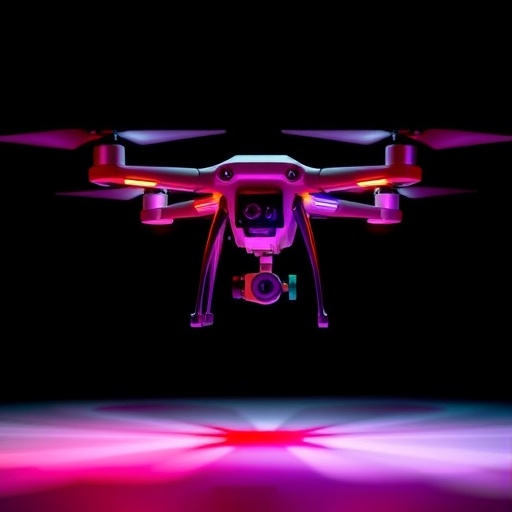In the dynamic field of aerospace engineering, a team of researchers led by Tao Song from Beijing Institute of Technology has made significant strides in addressing the challenges associated with unmanned aerial vehicle (UAV) landings on moving ships. This new approach introduces a flight envelope constrained fixed-time control strategy that not only ensures safe landings but also enhances the precision of UAV operations, particularly in precarious maritime environments.
The researchers have established that successful UAV landings require not just pinpoint precision in position but also a keen awareness of the ship’s movement. Ships tend to roll and pitch as a reaction to environmental conditions, thus complicating landing efforts. To mitigate these challenges, the team devised a systematic landing control strategy that incorporates a thorough understanding of ship motion dynamics. At the core of this strategy is a sophisticated predictive mechanism that allows UAVs to adjust their landings in real-time, based on how the ship is moving.
Specifically, a unique Sliding Data Window Auto-Regressive (SDW-AR) model was developed. This model predicts the roll and pitch movements of the ship with remarkable accuracy, thus allowing the UAV to determine an appropriate QP, or Quiescent Period, which signals when it is safe to execute the landing. The innovative aspect of the SDW-AR model lies in its variable-structure design. Unlike traditional modeling techniques, which often operate on fixed parameters, the SDW-AR dynamically updates its parameters based on live data feeds. This real-time adjustment enables the UAV to adapt swiftly to the ship’s current state and overall environment.
Given the unpredictable nature of the maritime setting, where waves, wind, and other factors can create turbulence, the research team’s development of a Barrier Function-based Non-Singular Terminal Sliding Mode Controller (BFNTSMC) further enhances landing performance. The BFNTSMC is engineered to maintain tracking precision within the identified QP and to optimize performance during the challenging touchdown phase. It effectively minimizes control overshoot, significantly reducing the risk of crashing or failing to land accurately.
To strengthen the UAV’s resilience against disturbances encountered during landing—such as unpredicted gusts of wind or sudden waves—the researchers integrated a Fixed-Time Disturbance Observer (FxTDO) into the BFNTSMC. This integration allows the UAV to compensate for external disturbances preemptively, which is essential for maintaining stable control during the landing sequence, even when external conditions are far from ideal.
Moreover, the researchers are cognizant of the limitations imposed by satellite navigation systems due to potential signal obstructions, jamming, or spoofing. As a result, they propose that future iterations of this research should include vision-based systems that can operate effectively without reliance on traditional navigation aids. This shift would allow UAV systems to function autonomously, thereby enhancing their applicability in a broader range of scenarios beyond just shipboard landings.
The recently published study in the esteemed Chinese Journal of Aeronautics encapsulates not only the technical complexities but also the potential applications these advancements could bring to maritime and aerial coordination. With an increasing number of UAV deployments in commercial and military domains, ensuring robust landing systems is crucial. The work spearheaded by Prof. Song and his team holds significant promise in advancing UAV capabilities in increasingly complex environments.
By establishing a model that incorporates advanced predictive analytics and robust control mechanisms, the researchers are paving the way for a future where UAVs can be deployed in environments previously deemed too hazardous for safe operation. This includes disaster response scenarios, naval operations, and logistics in congested or unpredictable environments.
As UAV technology continues to evolve, this research reinforces the need for ongoing innovation in control systems. As maritime environments are often volatile, the strategies developed by the Beijing Institute of Technology could rapidly transform how UAVs engage in operations over water, potentially reshaping both military and civilian applications in the aviation sector.
With the increasing recognition of the vulnerabilities inherent in current systems, the findings of this research serve as both a wake-up call and a beacon of hope for future developments. The quest for perfecting UAV landings on moving vessels underscores the ongoing interplay between engineering ingenuity and the realities of operational challenges faced on the front lines of technology application.
The work stands as a testament to the collective efforts within the engineering community to push boundaries and address real-world problems with practical solutions. As the team looks ahead, their commitment to refining these techniques will undoubtedly contribute to the growing body of knowledge in aerospace engineering, positioning them at the forefront of UAV innovation.
Such advancements are crucial not only for enhancing precision and safety but also for inspiring further research into autonomous systems capable of operating in the most challenging of environments. The implications of this work are vast, and as researchers continue to explore new methodologies and technologies, the future of UAV operations remains bright and filled with potential.
Finally, while current frameworks leverage existing technologies, the path forward is being built on foundational principles that emphasize adaptability and foresight. The techniques showcased in this study are merely the beginning of what’s possible, presenting an urgent call to action for engineers and researchers alike to continue pushing the envelope in UAV technology.
Subject of Research: UAV landing control on maneuvering ships
Article Title: Flight envelope constrained UAV shipboard landing control within an identified quiescent period
News Publication Date: 7-Mar-2025
Web References: Link
References: Cheng ZHANG, Tao SONG, Hong TAO, Tao JIANG. Flight envelope constrained UAV shipboard landing control within an identified quiescent period[J]. Chinese Journal of Aeronautics, 2025, 38(8): 103463.
Image Credits: Chinese Journal of Aeronautics
Keywords
UAV, shipboard landing, flight control, predictive modeling, barrier function, disturbance observer, aerospace engineering.




